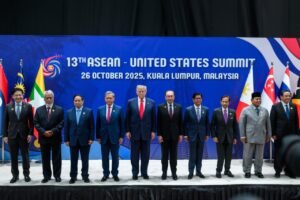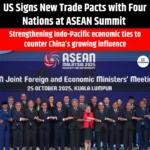US Signs New Trade Pacts with Four Nations at ASEAN Summit
|
General Studies Paper II: India and its Neighbourhood, Regional Groupings, Groupings & Agreements Involving India and/or Affecting India’s Interests |
Why in News?
The United States signed new trade pacts with four nations during the ASEAN Summit in October 2025, strengthening regional economic ties. These agreements aim to enhance cooperation, promote free trade, and counter growing global economic challenges through deeper strategic partnerships across Asia.
Association of Southeast Asian Nations (ASEAN) Summit 2025
- Venue: The 47th ASEAN Summit took place in Kuala Lumpur, Malaysia from 26 to 28 October 2025. Malaysia is the Chair for 2025 under the ASEAN rotation system.
- Theme: The theme for that summit year was “Inclusivity and Sustainability” emphasising the need for leaving no one behind and advancing sustainable development.
- Participation: All ten existing ASEAN member states attended, along with major dialogue partners including the United States, China, Japan, India, Australia and others.
-
- Membership Development: Timor‑Leste (East Timor) was formally admitted as the 11th member of ASEAN during the summit on 26 October 2025. This is the first expansion of membership since the 1990s.
- Key Agenda: The summit agenda covered a broad range of topics.
- Security and stability in the Indo-Pacific, especially maritime disputes and regional tensions, were central.
-
-
- Economic integration within ASEAN and with external partners featured prominently, including digital economy, supply chain resilience and trade frameworks.
- Climate change, sustainable development and regional connectivity were also key agendas on the table.
-
- India’s Engagement: For India, the summit held significant importance under its Act East Policy and Indo-Pacific vision. The Indian Prime Minister attended virtually rather than in person owing to domestic commitments (Deepavali festival). The goal from India’s side was to review progress in the ASEAN-India Comprehensive Strategic Partnership and to strengthen ties with the bloc.
U.S. Strategic Engagement and Trade Milestones
- On October 26, 2025, the United States joined multiple trade and investment frameworks with four Southeast Asian nations — namely Malaysia, Cambodia, Thailand and Vietnam — in Kuala Lumpur.
- The United States signed a reciprocal trade agreement with Malaysia during the Summit. This agreement commits both sides to open markets and reduce trade barriers. The deal strengthens the United States’ economic footprint in Southeast Asia.
- The U.S. also concluded a trade agreement with Cambodia that includes commitments involving export controls, dutyevading investigations, and investment screening.
- The United States also signed agreements with Thailand and Vietnam on trade cooperation and supply-chain resilience, although these are not full reciprocal agreements. They set the stage for deeper future access for American goods and services. Thailand agreed to explore eliminating tariffs on 99 % of goods under one framework.
- The U.S. secured critical minerals supply-chain partnerships with Malaysia and Thailand. Malaysia agreed not to ban or restrict the U.S. bound exports of rare earth elements.
- The United States retained a tariff rate of about 19 % (20 % for Vietnam) for the four countries as part of the framework, with the prospect of selected tariff lines moving to zero-percent over time as market access improves.
- The United States played a role in facilitating the peace accord between Thailand and Cambodia, known as the Kuala Lumpur Peace Accord signed during the Summit. U.S. President Donald J. Trump acted as a witness alongside Malaysia’s Prime Minister in the ceremony on 26 October 2025.
- All these trade agreements include clauses on export controls and investment screening aimed at “third-countries” (widely read as China). By doing so, the U.S. made clear that its engagement in ASEAN is shaped by strategic rivalry, not just commercial interest.
Significance of U.S. Engagement at the ASEAN Summit 2025
- Boost in Trade Volume: The U.S.-ASEAN trade relationship now involves around US $571.7 billion in goods and services in 2024, marking a 13.4 % increase over 2023. Through agreements signed at the summit, U.S. exporters gain new access to Southeast Asian markets, which strengthens America’s economic footprint in a high-growth region.
- Supply-Chain Realignment: The new trade frameworks place emphasis on critical minerals, export controls, and investment screening. This matters because Southeast Asia is becoming a key link in global production and resource chains, offering the U.S. opportunities to diversify away from over-reliance on certain partners.
- Geopolitical Leverage: By engaging deeply with ASEAN countries, the U.S. strengthens its strategic posture in the Indo-Pacific region. The deals announced cover roughly 68 % of the U.S. two-way trade with the ten ASEAN nations, emphasising how economic instruments now support broader foreign-policy goals. By convening dialogue partners and major powers, ASEAN sought to maintain a balanced role amid U.S.–China competition.
- Regional Economic Growth: ASEAN economies are among the fastest-growing in the world and have around 700 million people. When the U.S. expands trade and investment in this region, it contributes to job creation, infrastructure, and industrial development within ASEAN countries.
|
Association of Southeast Asian Nations (ASEAN) Summit
|
|
Also Read: 25th SCO Summit in China |










